Italy dazzles the senses like nowhere else—where timeless art, stunning architecture, and mouthwatering cuisine come together to inspire and delight at every turn.
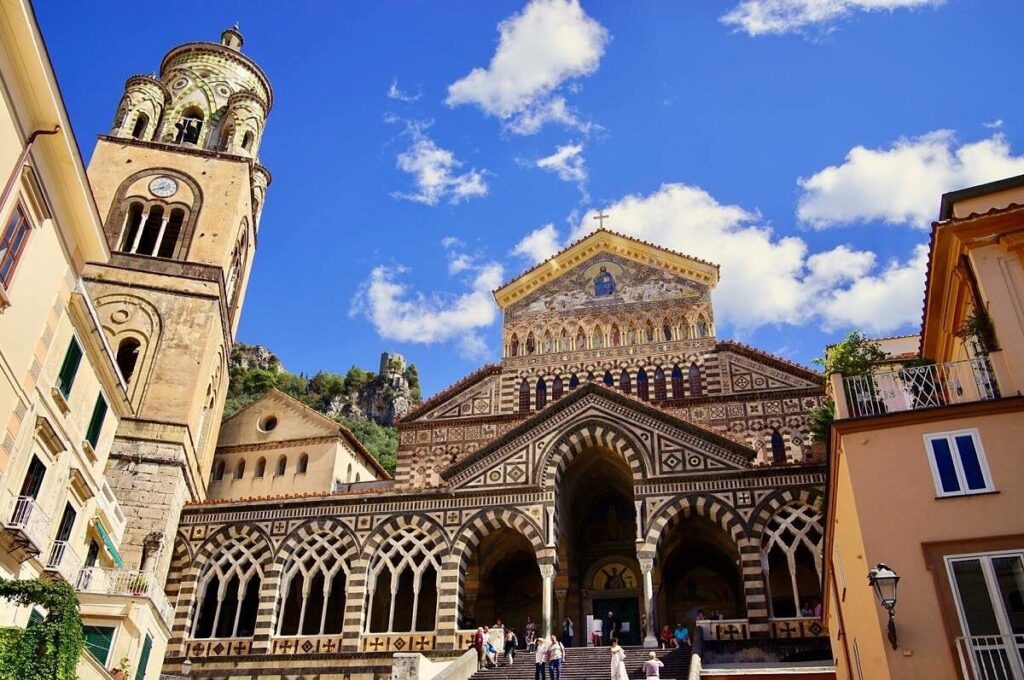
Once a proud symbol of Amalfi’s maritime power, the Cattedrale di Sant’Andrea remains the town’s most iconic monument. No trip to the Amalfi Coast feels complete without a photo on its dramatic staircase—a rite of passage for travelers and a postcard-perfect snapshot of your visit.
This stunning cathedral reflects Amalfi’s rich history as a Mediterranean crossroads. Its unique architecture is the result of centuries of renovation and cultural influences—from Byzantine to Arab-Norman and Baroque. The monumental complex includes not just the main cathedral but also the atrium, the Cloister of Paradise, the Crypt, and the Church of the Crucifix.
Originally built in the 6th century BCE and expanded in the 13th century, the cathedral houses the relics of St. Andrew, brought from Constantinople in 1208. Its impressive bronze doors, cast in Constantinople in 1057, were the first of their kind in Italy—testament to Amalfi’s once-glorious stature.
Start your visit at Piazza Duomo, the vibrant square at the cathedral’s base. The 62-step staircase elevates the cathedral 20 metres above street level, making the climb a rewarding experience in itself. Admire the ornate façade of mosaics, striped columns and arched windows, then pause in the atrium for shade and a striking photo framed by the triple-arched windows.
Step into the serene Cloister of Paradise, built in the 1260s as a burial place for Amalfi’s noble families. Surrounded by 120 slender columns and Arabic arches, the cloister is an oasis of calm. Bright white marble and lush Mediterranean greenery offer a stark contrast to the cathedral’s grandeur. Ancient sarcophagi and frescoes dating back to the 13th century line the walls, revealing scenes from classical mythology and early Christian iconography.
The Basilica of the Crucifix, the original 6th-century church, now houses the Diocesan Museum and is rich with Roman columns, Gothic details and religious frescoes. From here, descend into the Crypt of St. Andrew, a richly decorated Baroque space built under the patronage of King Philip III of Spain. At its heart lies a sacred ampulla said to hold the miraculous “manna,” a liquid that emerges from the tomb of St. Andrew on his feast days—June 27 and November 30—which are celebrated with processions and festivals.
The current cathedral interior showcases a majestic Baroque design with a gilded ceiling and dramatic paintings by Francesco Solimena. The side chapels represent a fascinating blend of styles—from Moorish to Renaissance—reflecting the layered heritage of the building.
Tickets: Free for mass and religious services. Access to the full Monumental Complex (Cloister, Crypt, and Museum) is €3.
Opening Hours:
March–June: 9:00 am – 6:45 pm
July–September: 9:00 am – 7:45 pm
November–February: 10:00 am – 1:00 pm & 2:30 pm – 4:30 pm
Dress Code: Modest attire is required; shoulders and knees should be covered.
Before or after your visit, take a moment at the Fountain of Sant’Andrea in Piazza Duomo. Sculpted in the 1500s, it features the saint holding his iconic cross, surrounded by mythological figures including a siren, a satyr, and an eagle—each a nod to Amalfi’s rich blend of religion, legend, and seafaring legacy.
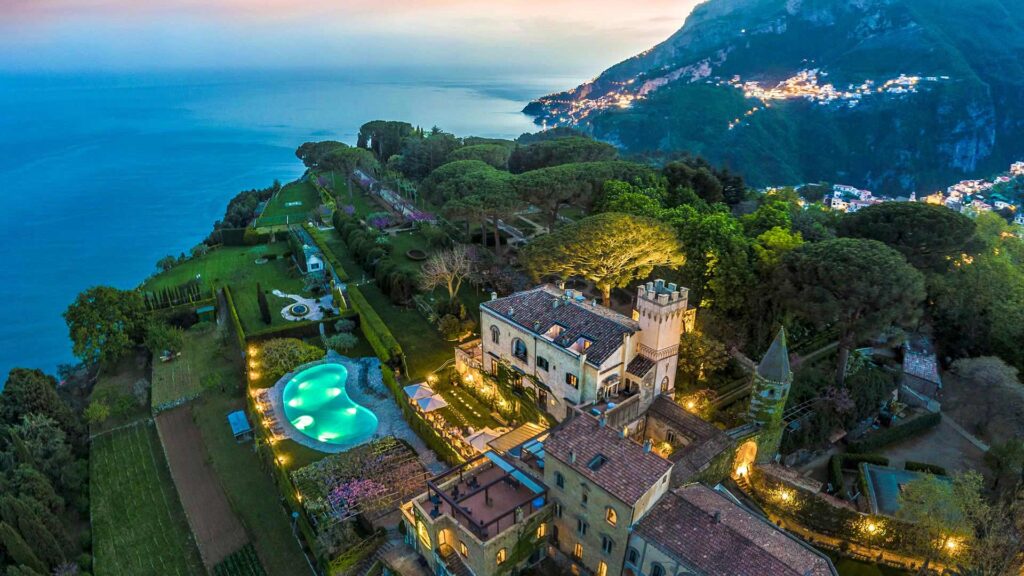
If you only have time to visit one place in Ravello, make it Villa Cimbrone. Just a 10-minute walk from the town’s main square, this stunning estate feels like an entirely different world—an open-air museum perched above the Amalfi Coast.
With its elegant gardens, classical sculptures, and sweeping sea views, Villa Cimbrone is a sanctuary of romanticism. Spread across nearly 15 acres, its grounds blend English and Italian styles with architectural elements spanning centuries and cultures. The result is a dreamlike landscape that has inspired artists, poets, and travelers for over a century.
Strolling through the gardens, you’ll encounter tourists from around the world—some here to explore, others to celebrate weddings or concerts set against the backdrop of the Tyrrhenian Sea. But no visit is complete without a photo at the famed Infinity Terrace.
Walking through ivy-covered cloisters and faux-Gothic arches, you’ll find yourself at the Infinity Terrace, Villa Cimbrone’s most iconic spot. Guarded by a statue of Ceres, goddess of the harvest, the terrace opens to a view that feels eternal: 300 meters above sea level, where the sea and sky merge in hues of deep blue.
The air feels sacred up here. From this vantage point, the town of Amalfi lies far below and the mountains of Cilento peek out in the distance. Time seems to stand still.
Beyond the belvedere, the gardens continue to enchant. Follow tree-lined paths to the Hill of Mercury, where a bronze Hermes rests beneath ancient oaks. A nearby inscription, attributed to Catullus, captures the spirit of the place:
“Lost to a world in which I crave no part,
I sit alone and commune with my heart…”
Continue exploring and you’ll discover the Temple of Bacchus, Eve’s Grotto, the Avenue of Hortensia, a replica of Donatello’s David, and even a Moorish-style tea room. The Avenue of Immensity, draped in wisteria, leads you toward the Rose Terrace, a geometric floral masterpiece that blooms from May to October.
The hilltop once known as Cimbronium has been home to noble families since the Middle Ages. In 1904, English nobleman Lord Beckett purchased Villa Cimbrone and transformed it into a romantic retreat. It became a haven for the Bloomsbury Set—Virginia Woolf, Vita Sackville-West, T.S. Eliot, and E.M. Forster among them.
Over the decades, it has hosted luminaries like Winston Churchill, economist Maynard Keynes, and actress Greta Garbo, who famously eloped here with Leopold Stokowski in 1938.
Getting there: It’s only a 10-minute walk from Piazza Duomo, but the route is steep and winding. Wear comfortable shoes and don’t be surprised if you feel lost—the charming alleys are part of the experience.
Best time to visit: Go early in the morning or later in the afternoon to avoid the midday heat (11am–3pm). Bring water—there are no fountains inside, and the on-site café is expensive.
Admission: Entry to the gardens costs €10 and is available daily from 9am until sunset. Tickets are sold at the entrance. Guided tours can be arranged through Hotel Villa Cimbrone.
Today, the villa itself operates as a luxury hotel. Behind its 12th-century facade lie frescoed rooms, antique furnishings, and gourmet experiences—including the Michelin-starred Il Flauto di Pan, the rustic-inspired Mediterraneo, and several elegant lounges and bars.
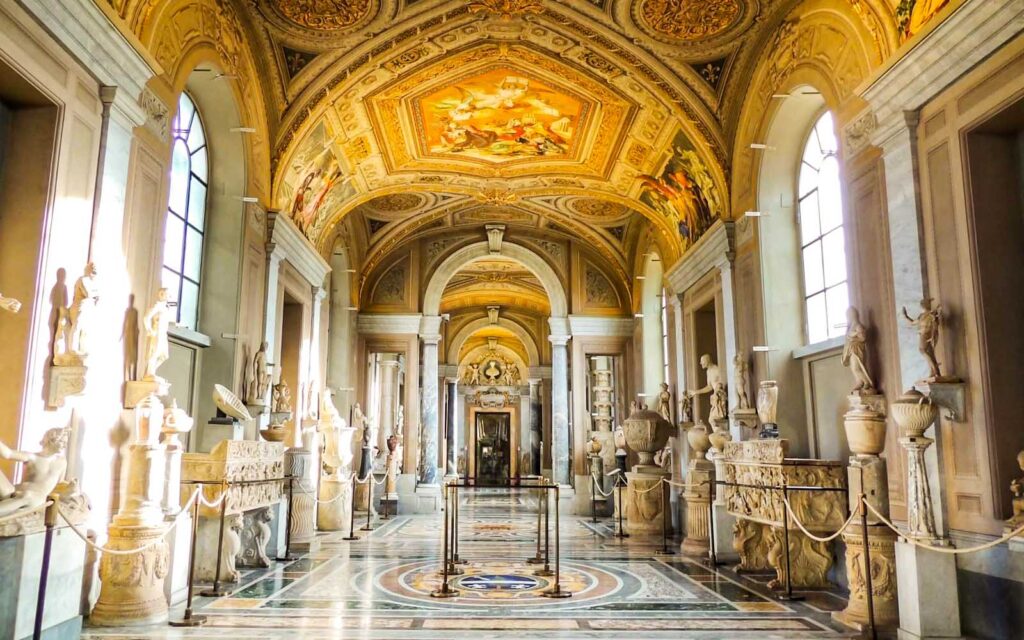
Home to the Sistine Chapel and one of the world’s most celebrated art collections, the Vatican Museums span over 7km of galleries and 26 museums, offering a breathtaking glimpse into centuries of human creativity.
Founded in the early 16th century by Pope Julius II, the museums began with classical sculptures in the Octagonal Courtyard. Over time, popes enriched the collections with Renaissance masterpieces, ancient artifacts, and modern additions. Highlights include the Museo Pio-Clementino, Raphael Rooms, Map Gallery, and of course, the Sistine Chapel, where Michelangelo’s ceiling and Last Judgment awe visitors to this day.
Start at: Cortile delle Corazze → Museo Pio-Clementino (Laocoön, Apollo Belvedere)
Continue through: Gallery of the Candelabra → Tapestry Gallery → Map Gallery
Then: Raphael Rooms (featuring School of Athens)
Finish with: The Sistine Chapel, home to The Creation of Adam and The Last Judgment
Pinacoteca: Masterpieces by Raphael, Leonardo da Vinci, and Caravaggio
Braccio Nuovo: Statue of the Nile with 16 babies
Egyptian & Etruscan Museums: Rare archaeological finds
Standard ticket: €17 (plus €5 if booked online)
Best time to visit: Tuesdays & Thursdays; afternoons are quieter
Open: Mon–Sat (9am–6pm); last Sunday of each month (free, until 2pm)
Dress code: No bare shoulders or short skirts/shorts
Photography: Allowed (no flash/tripods), not in the Sistine Chapel
Inside: Bistro at Cortile della Pigna & self-service cafes
Nearby: Try Bonci Pizzarium for exceptional pizza al taglio
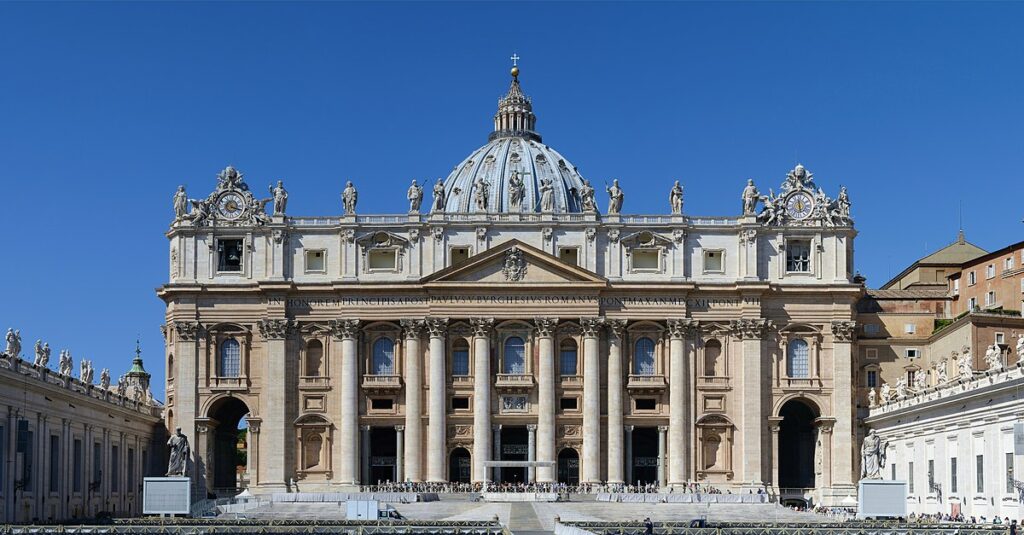
Even in a city full of magnificent churches, St Peter’s Basilica stands out. From the grand colonnaded piazza that welcomes visitors to its lavish interior, every aspect of this iconic site is awe-inspiring. It’s home to two of Michelangelo’s most treasured works: the Pietà and the basilica’s towering dome, a defining feature of the Roman skyline.
The original basilica, built in the 4th century by Emperor Constantine over the believed burial site of St Peter, eventually fell into decay. The present-day basilica was begun in 1506, but progress stalled after chief architect Bramante died. Successive architects, including Raphael, made modifications without much advancement.
A turning point came in 1547 when Michelangelo took over, simplifying the design and drafting the plans for what became his crowning achievement: the dome. Although he didn’t live to see it completed, it was finished in 1590 by Giacomo della Porta and Domenico Fontana. Carlo Maderno later added the grand façade and extended the nave. The basilica was finally consecrated in 1626.
Admire Maderno’s monumental façade (1608–1612), which rises 48m and spans 115m, featuring eight massive columns and statues of Christ, St John the Baptist, and 11 apostles. The central Loggia della Benedizione is where the pope delivers his Urbi et Orbi blessing on major religious occasions.
Above it, a Latin inscription honors Pope Paul V and marks the year 1612, the seventh of his pontificate.
Inside, the basilica stretches 187m and covers over 15,000 sq m. Notable highlights include:
Michelangelo’s Pietà: His only signed work, sculpted when he was just 25, located in the right nave.
A red floor disc marking where Charlemagne and later emperors were crowned.
Bernini’s Baldachin: A massive bronze canopy over the papal altar, made from bronze taken from the Pantheon.
Michelangelo’s dome, inspired by Brunelleschi’s design in Florence, rises 119m and is supported by four great piers with statues of Longinus, Helena, Veronica, and Andrew.
St Peter’s bronze statue by Arnolfo di Cambio – its foot worn smooth by centuries of pilgrims’ touches.
Museo del Tesoro (€5): Contains sacred relics, including Donatello’s tabernacle and the jewel-studded Crux Vaticana.
Vatican Grottoes: Free to visit, they house tombs of popes and remains from the original basilica.
Vatican Necropolis: Home to St Peter’s tomb; access by guided Ufficio Scavi tour (€13) only – booking required.
Get breathtaking views of Rome by climbing the dome:
€8 to climb all 551 steps
€10 with elevator (up to the terrace, 320 steps remain)
Tickets are sold at the entrance to the right of the basilica’s main portico. Note: the climb is steep and narrow – not ideal for those with claustrophobia or vertigo.
You can attend mass with the pope by requesting free tickets via the Prefecture of the Papal Household. These are in high demand, so apply early—especially for Easter and Christmas services.
Opening hours: Daily, 7am–6.30pm (till 7pm in summer)
Entry: Free (security screening at the piazza entrance)
Best time to visit: Lunchtime or late afternoon to avoid crowds
Dress code: Strictly enforced—no bare shoulders, mini skirts, or short shorts
Free tours led by seminarians from the Pontifical North American College are offered Mon–Thurs at 2:15pm (from the south side of St Peter’s Square). No ticket needed—check the official website for details.
Getting there:
Metro A: Ottaviano stop
Bus: 40 or 64 from Termini station
Avoid tourist traps near the basilica and explore Prati, a nearby neighborhood:
Re-bìo: Great for organic salads and panini
Il Sorpasso: A stylish local favorite for a full Italian meal
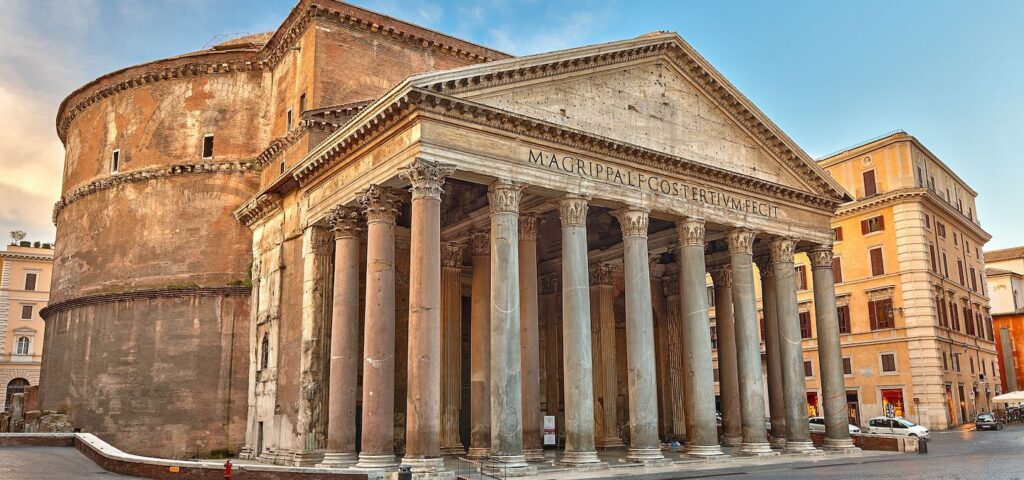
A striking 2000-year-old temple built to honor the seven planetary deities and later converted into a church, the Pantheon is the best-preserved ancient monument in Rome and one of the most influential buildings in Western architecture.
Commissioned by Emperor Hadrian around 125 CE on the site of Marcus Agrippa’s earlier 27 BCE temple, the Pantheon stuns visitors with its scale and design. Step through the massive bronze doors, and you’ll be greeted by the world’s largest unreinforced concrete dome, still unmatched centuries later.
At the center, a 9m-wide oculus (circular opening) pours light into the vast marble interior, creating an ethereal glow and symbolizing a connection between heaven and earth.
The dome, once the largest in the world, remains a wonder of Roman engineering. Using lighter materials toward the top, the structure maintains perfect balance without support – a feat that continues to inspire architects even today.
Though the façade still bears the inscription “M·AGRIPPA·L·F·COS·TERTIVM·FECIT” (“Marcus Agrippa, son of Lucius, built this in his third consulate”), we now know Hadrian rebuilt the temple and preserved Agrippa’s inscription.
Originally dedicated to all the gods (Pantheon comes from the Greek pan = all, theos = god), the structure was consecrated as a Christian church in 609 CE, becoming the Basilica di Santa Maria ad Martyres. This Christianization spared it from the destruction that befell many pagan temples.
In 1625, Pope Urban VIII controversially removed bronze from the portico roof to craft Bernini’s baldachin at St Peter’s Basilica, prompting Romans to quip: “What the barbarians didn’t do, the Barberini did.”
Façade: 16 towering Corinthian columns, each 11.8m high and made from single blocks of Egyptian granite, support a massive triangular pediment.
Interior: The marble-clad rotunda houses the tombs of artist Raphael, and Italian kings Vittorio Emanuele II and Umberto I.
Opening hours: Daily, 9am–7pm (closed Jan 1 & Dec 25)
Tickets: €5 general admission (introduced July 2023)
Booking required on weekends and holidays via the official site.
Audio guide: €10 | Guided tours from €20
Mass times: No tourist access during services
– Saturdays from 5pm, Sundays from 10:30am
Special event: On Pentecost, thousands of red petals rain down through the oculus, symbolizing the descent of the Holy Spirit.
La Casa del Caffè Tazza d’Oro: A legendary Roman café – don’t miss the granita al caffè, perfect on a hot day.
Sant’Eustachio Il Caffè: Another iconic espresso stop, beloved by locals.
Ginger: On the opposite side of the Pantheon, this trendy spot offers everything from burgers and sandwiches to full meals in a bright, modern setting.

With its ornate fountains, baroque palazzi, and lively mix of street performers, hawkers, and tourists, Piazza Navona is the heart of elegant, open-air Roman life. Built atop the 1st-century Stadio di Domiziano, the square was paved in the 15th century and served as Rome’s central market for nearly 300 years.
Piazza Navona is one of Rome’s most picturesque and animated public spaces. To see it at its finest, visit early in the morning before the crowds arrive, or come after dark when the fountains are beautifully illuminated. Don’t forget to fill your bottle at the nasone (“big nose”) drinking fountain at the piazza’s north end.
In December, the piazza transforms into a festive wonderland with a traditional Christmas market that runs until January 6.
The piazza’s dramatic centerpiece is Bernini’s Fontana dei Quattro Fiumi (Fountain of the Four Rivers). Topped with an Egyptian obelisk, it features muscular personifications of four great rivers: the Nile, Ganges, Danube, and Rio de la Plata.
A popular legend claims the Nile figure shields his eyes to avoid looking at the Chiesa di Sant’Agnese in Agone, designed by Bernini’s rival Borromini. In reality, Bernini completed the fountain before Borromini began the church, and the gesture simply reflects the Nile’s then-unknown source.
Other fountains in the square include:
Fontana del Moro (southern end) – Designed by Giacomo della Porta in 1576; Bernini added the Moor figure in the 17th century. The surrounding Tritons are 19th-century copies.
Fontana del Nettuno (northern end) – A 19th-century fountain depicting Neptune battling a sea monster, surrounded by sea nymphs.
Chiesa di Sant’Agnese in Agone: A stunning baroque church by Borromini, believed to stand on the site where Saint Agnes was martyred. Legend says her hair miraculously grew to shield her body after being stripped by her executioners. The church regularly hosts classical concerts.
Palazzo Pamphilj: Built between 1644–1650 by Borromini and Rainaldi, this elegant baroque palace was commissioned by Pope Innocent X. It houses frescoes by Pietro da Cortona and now serves as the Brazilian Embassy. Visits are by pre-booked guided tour only.
Stadio di Domiziano: The square’s shape and size mirror the ancient 30,000-seat stadium that once hosted athletic games. The name Navona derives from the Greek “agon” (games). Its ruins can be explored from Via di Tor Sanguigna.
Piazza Navona is surrounded by dining options for every taste—from high-end restaurants to gelaterias and Roman street-food spots. Beware of tourist traps; instead, try these local favorites:
Vivi Bistrot – Located in Palazzo Braschi, this charming café is perfect for a relaxing lunch.
Etablì – A cozy bar-restaurant tucked into the winding streets west of the square.
For authentic Roman-Jewish cuisine, head south to the Jewish Ghetto, a historic and atmospheric district full of culinary gems.
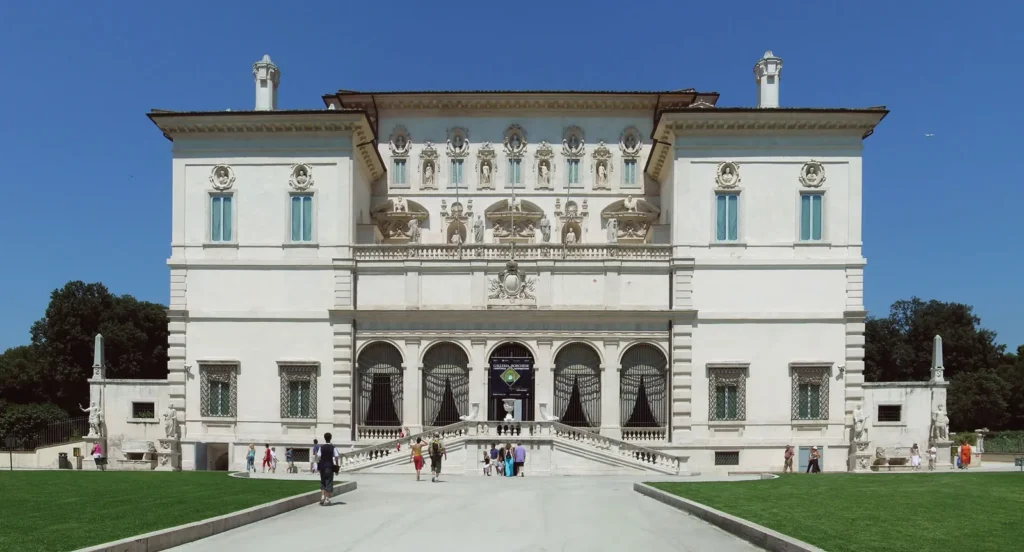
If you only have time for one art gallery in Rome, make it this one. The Galleria Borghese is home to what many call the queen of all private art collections, featuring masterpieces by Caravaggio, Raphael, Titian, and Canova, along with jaw-dropping sculptures by Bernini.
Among the unmissable highlights:
Bernini’s Ratto di Proserpina (The Rape of Proserpina)
Canova’s Venere Vincitrice (Venus Victrix)
This extraordinary collection was assembled by Cardinal Scipione Borghese (1577–1633), a passionate—and often ruthless—art collector. Originally housed near St Peter’s Basilica, the collection was moved in the 1620s to a grand new villa just outside Porta Pinciana. Today, it remains in the heart of Villa Borghese Park, within the villa’s elegant Casino Borghese.
The building itself reflects centuries of refinement, most notably the 18th-century neoclassical enhancements commissioned by Prince Marcantonio Borghese.
The Galleria is divided into two main sections:
Ground Floor: Sculpture gallery, ancient Roman mosaics, and elaborately frescoed rooms.
Upper Floor: Renaissance and Baroque paintings, including works by some of the greatest names in art history.
Entrance Hall: Begins with 4th-century mosaics of battling gladiators and a 2nd-century statue of a Fighting Satyr. Look up for Pietro Bernini’s dramatic Marco Curzio a Cavallo, a bas-relief of a horse and rider plunging into the void.
Sala I: Canova’s Paolina Borghese as Venus Victrix (1805–08) stuns with her calm, confident nudity—posing as the goddess of love.
Sala III: Bernini’s Apollo e Dafne (1622–25) captures the instant Daphne begins transforming into a laurel tree to escape Apollo’s pursuit.
Sala IV: Bernini’s Ratto di Proserpina (1621–22)—an astonishing example of sculptural realism, where Pluto’s hand presses into Persephone’s thigh as if it were living flesh.
Sala VIII: A Caravaggio showcase. Here you’ll find:
Bacchino Malato (Young Sick Bacchus, 1592–95)
Madonna dei Palafrenieri (Madonna with Serpent, 1605–06)
San Giovanni Battista (St John the Baptist, 1609–10)
Ragazzo col Canestro di Frutta (Boy with a Basket of Fruit, 1593–95)
Davide con la Testa di Golia (David with the Head of Goliath, 1609–10) — with Goliath’s severed head believed to be a self-portrait.
Sala IX:
Raphael’s La Deposizione di Cristo (The Deposition, 1507)
Raphael’s Dama con Liocorno (Lady with a Unicorn, 1506)
Fra Bartolomeo’s Adorazione del Bambino (1495)
Perugino’s Madonna con Bambino (early 1500s)
Sala X: Correggio’s Danaë (1530–31) – a sensual interpretation of the myth.
Sala XIV: Self-portraits by Gian Lorenzo Bernini.
Sala XX: Titian’s Amor Sacro e Amor Profano (Sacred and Profane Love, 1514) – one of the gallery’s most famous works.
Entry: Timed admission only; visits are limited to two-hour slots. Advance booking is essential.
Tickets: €13 + €2 booking fee. Reserve via the official Galleria Borghese website.
Audio Guide: €5, available in the basement ticket office, which also includes a coat check and small café.
Closed: Mondays
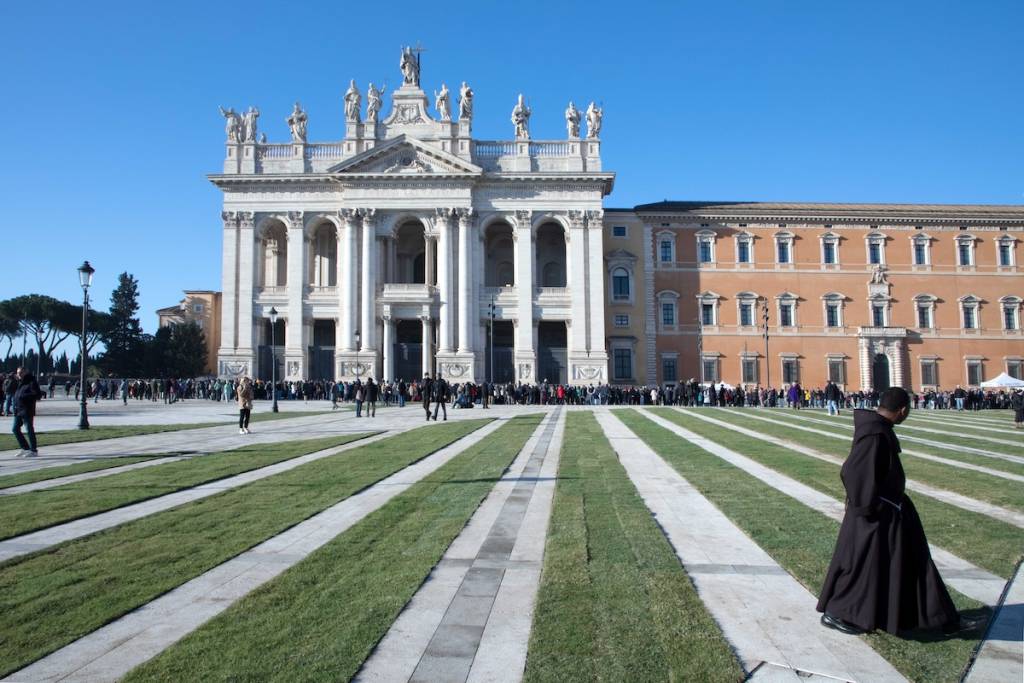
For over a thousand years, this monumental basilica was the most important church in Christendom. Commissioned by Emperor Constantine and consecrated in AD 324, it was the first Christian basilica built in Rome and served as the pope’s principal place of worship until the late 14th century. Even today, San Giovanni in Laterano remains the official cathedral of Rome and the pope’s ecclesiastical seat as bishop of the city.
The basilica was constructed over the earlier Church of San Salvatore, established after Constantine legalized Christianity in the Roman Empire. Through centuries of wars, fires, and reconstructions, the basilica underwent numerous transformations.
The current structure largely reflects the 17th-century renovations by Francesco Borromini, commissioned by Pope Alexander VII for the Jubilee of 1650. Borromini preserved key elements of the earlier church—such as the floor, apse mosaic, and ciborium. The imposing façade, however, was added later, completed in 1732 by Alessandro Galilei.
Facade & Statues: Towering 157 meters (515 feet) above, the façade is crowned with colossal statues of Christ, St John the Baptist, St John the Evangelist, and the 12 Apostles.
Historic Doors: The central bronze doors, once part of the Roman Forum’s Curia, were relocated here. To the far right, the Holy Door is ceremoniously opened only during Jubilee Years.
Interior Grandeur:
The gilded ceiling gleams above a vast nave lined with powerful 4.6-meter-tall statues of the Apostles.
The mosaic floor, dating from the 15th century, adds rich historical texture.
The Gothic baldachin over the papal altar is believed to house relics of the heads of Saints Peter and Paul.
The Confessio: Below the main altar, a double staircase leads to a quiet chapel featuring a wooden statue of St John the Baptist and the Renaissance tomb of Pope Martin V.
Apse Mosaics: The apse dazzles with gold and glass mosaics, some from the 4th century, though most were restored or added in the 1800s.
Museo del Tesoro: Hidden through a small gift shop to the right of the apse, this Treasury Museum holds sacred artifacts, vestments, and ecclesiastical items.
Giotto Fresco & Papal Legend: In the right-hand aisle, look for an unfinished fresco by Giotto. Nearby, a monument to Pope Sylvester II (r. 999–1003) is famously said to sweat and creak when a pope’s death is imminent.
The Cloister: A peaceful 13th-century cloister with gracefully twisted columns surrounds a central garden—accessible to the left of the altar.
Entry: Free to the basilica.
Cloister & Museum:
Entry to the Cloister is usually ticketed.
The Palazzo Lateranense Museum nearby offers a fascinating collection of papal artifacts and church treasures.
Guided tour tickets cost €17.50, available on the official museum website.
WhatsApp us